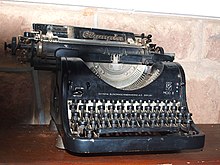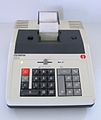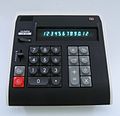Olympic works
| Olympic works
|
|
|---|---|
| legal form | Corporation |
| founding | August 15, 1903 |
| resolution | Late 1992 |
| Seat | Schortens |
| Branch | Office machines |
| Website | www.olympia-vertrieb.de |
The Olympia-Werke in Roffhausen near Wilhelmshaven were a major German manufacturer of typewriters . Since the plant was closed in 1991, only the brand name has remained.
history
Emergence
When the “young” typewriters attracted more and more attention and interest at the beginning of the 20th century, the Allgemeine Elektricitäts-Gesellschaft (AEG) in Berlin commissioned the engineer and electrical engineer Friedrich von Hefner-Alteneck to develop such a device. Von Hefner-Alteneck then designed the Mignon , an inexpensive pointer typewriter that was affordable not only for larger companies, but also for craftsmen and private individuals. The distribution of the machine was transferred to Union Typewriter Company mbH on August 15, 1903 , from which the Olympia-Werke emerged.
In 1912, besides the "Mignon", the manufacture of lever type typewriters began , which expanded after the First World War, so that in 1923 AEG Deutsche Werke was founded in Erfurt .
From 1930 this company operated as Europa Typewriter AG ; the products received the internationally protected brand name "Olympia". The last “Mignon” from 1933 was called the “Olympic Plurotype”.
On December 31, 1936, the company name (company) was changed to Olympia Büromaschinenwerke AG .
In World War II also was cipher machine Enigma produced. For reasons of secrecy , the latter did not have the company name on the nameplate, but the coded manufacturing code aye . The plant in Erfurt was badly damaged by US artillery fire from April 11 to 13, 1945 . In the period after Erfurt was handed over to the Soviet occupying power on June 3, 1945, the operating facilities that had been preserved became a “state-owned company ” that produced typewriters as VEB Optima Büromaschinenwerke .
New beginning after the Second World War
The plant in Wilhelmshaven came into being after the Second World War, when employees of the Erfurt plant and construction documents fled to the West and initially founded the Bielefelder Typewriter Works in Bielefeld . At the end of 1945 the board of directors of the Bielefeld company came across the former naval equipment warehouse of the naval administration in Roffhausen while looking for more suitable production facilities and qualified skilled workers. On October 1, 1946, the military government issued the production permit. In the starting year, the workforce consisted of 28 employees. Under difficult conditions, the production of type lever typewriters began, which was soon sold successfully - not least due to the high demand during the economic boom . At the end of 1947 the name was changed to Orbis Typewriter Works . The SM series began in 1948 .
In 1949 the International Court of Justice in The Hague had to clarify whether the West or East German company was allowed to use the traditional name “Olympia”. The court ruled that only the Wilhelmshaven plant could henceforth use the company and brand name Olympia. The Erfurt plant then called itself Optima Büromaschinenwerk Erfurt and its product lines "Optima". For the Wilhelmshaven plant, the company was called Olympia Werke West GmbH from 1950 and from June 1954 the company was renamed Olympia Werke AG .
Expansion and end
Sales, profits and the number of employees rose continuously. In 1957 the workforce reached a new high with around 12,000 men and women. Everywhere in the northwest, extended workbenches were built that supplied parts for production in Roffhausen. In 1957 a new plant was built in Leer that employed up to 2,500 people. In this factory, travel and small typewriters were specially manufactured.
The company continued to expand through acquisitions. In 1957 the company initially took a stake in the well-known calculating machine manufacturer Brunsviga Maschinenwerke GmbH in Braunschweig and took over the entire company two years later. The production of Olympic balancing machines was then relocated to Braunschweig and the focus was on the development and manufacture of four-species machines , which continued to be sold under the Brunsviga name.
1959 began in Roffhausen with the construction of electric typewriters of the type "SGE". In 1961, every second typewriter produced in Germany came from Olympia. In 1962, AEG acquired further shares in Olympia-Werke and now owned the entire share capital of Olympia Werke AG amounting to DM 55 million. In 1969, the typewriter factory Alpina Büromaschinen in Kaufbeuren was taken over and three new production halls were built in Roffhausen with an investment of around 10 Millions DM. Olympia now also expanded internationally and, in addition to the plants in Roffhausen, Braunschweig, Leer, Norden and Kaufbeuren, also produced in Belfast , Mexico City , Santiago de Chile and Toronto . The total workforce exceeded the 20,000 mark in early 1969. Olympia was not only the number one German office machine manufacturer, it was also one of the three largest office machine manufacturers in the world.
The inauguration of Hall 1 of the Hanover Fair CeBIT 1970 - "Center for Office and Information Technology" was a high point in the company's history for Olympia. By the end of the 1950s, the office industry had advanced to third place among all branches of industry exhibiting at the Hanover Fair. In 1970 Olympia was the largest exhibitor in the new CeBIT hall. Here, the Olympia Multiplex 80, a computer-controlled data acquisition system, was presented. The first installation was successfully completed in 1969 at Deutsche Bank Hamburg. By 1976, 70 data acquisition systems of the type "Multiplex 80" with a total value of more than 10 million marks had been installed. Commercial applications predominated in the system, which was sold in two ways: Olympia was responsible for sales for the banking and savings bank sector - for operating data acquisition in other sectors, the Multiplex 80 was offered directly by the manufacturer Kabel- und Metallwerke Gutehoffnungshütte AG (Kabelmetal) .
From the mid-1960s onwards, Olympia manufactured not only mechanical but also electronic calculating machines that displayed digits with the help of Nixie tubes . At the end of the sixties, however, these machines, equipped with hundreds of transistors and diodes , were already much too heavy and expensive and therefore inferior to Japanese machines on the market. This situation was countered in the early 1970s through a cooperation in the computer sector with Matsushita in Japan. Other components such as copiers may have been used. a. bought from Agfa . The emerging decline of classic office technology in view of the spread of small computers also showed the end of Olympia Werke AG. The parent company AEG, meanwhile bought by Daimler , could not give any decisive innovative impulses.
From the mid-1980s, the bad economic news about AEG Olympia AG increased. After years of losses, the corporate headquarters of the parent companies AEG and Daimler-Benz decided in December 1991 to withdraw from office communication and to close the location with its workforce of around 3,600. Under the motto “Olympia - the heart of the region must live on”, a labor dispute of the Olympic employees, which was noticed nationwide, followed over the next few months to keep their jobs. Campaigns in Wilhelmshaven, Frankfurt and Stuttgart reminded of the responsibility of the Daimler-Benz group and increased public pressure to create replacement jobs in the Wilhelmshaven / Friesland region. Nevertheless, the closure of the location in Roffhausen at the end of 1992 could not be prevented. As a positive result of the labor dispute, the concept for a TCN (Technologie-Centrum Nordwest) was developed, which provided for the outsourcing and continuation of operational parts of the Olympia as an independent company as well as the settlement of new companies on the grounds of the TCN. The concept received support from the state government of Lower Saxony, the parent company Daimler-Benz, the district of Friesland , the city of Schortens and the employee representatives. At the beginning of 1993 the TCN had 14 companies with around 750 employees. In 2012 the newly established naval support command moved into premises in the TCN.
Parts of AEG Olympia AG were converted into smaller, economic companies. The Olympia Office Vertriebsgesellschaft mbH was created to sell the now mostly purchased office machines, the OSG Office Service GmbH , which offered a brand-independent service for office machines still on the market, and a company as the owner of the real estate and production facilities. The successor companies OSG Office Service GmbH and Olympia Office Vertriebsgesellschaft mbH did not remain in the possession of the AEG group for long. The OSG Office Service GmbH was May 1, 1993 the company Elcosa AG in Schaffhausen a new owner. The Olympia Office Vertriebsgesellschaft mbH with the brand name Olympic, worldwide distribution network and production facility in Mexico City was on July 1, 1994 by the elite group in Hong Kong adopted and as Olympia International Holdings Ltd. , based in Road Town continued in the British Virgin Islands.
Today there is only the rights to the brand name "Olympia", which is held in Germany by the entrepreneur Heinz Prygoda. Olympia International Holdings Ltd as successor and Prygodas Olympia Business Systems Vertriebs GmbH still bear the brand name. The Olympia Business Systems Vertriebs GmbH merged early in 2019 with the Wiesbaden-based office products wholesaler GENIE GmbH & Co. KG , formerly Dieter Gerth GmbH , the GO Europe GmbH , based in Hattingen .
Trivia
The story of my typewriter by Paul Auster is a small book about the author's old Olympia typewriter with pictures by the painter Sam Messer . Even Woody Allen has worked until recently with the Olympics.
Products
Typewriters
Computing devices
Desk calculator CA 12
Olympia CD 101 desktop calculator, around 1973/74, built by Matsushita Electric Industrial
literature
- Werner von Eye: History of the Typewriter . Georg Achterberg, Verlag für Berufsbildung GmbH, Berlin 1958.
- Herbert Morgenbesser: Large German companies . Volume 4. Hans-Christoph Reisner Verlag, Berlin 1962
- Hans-Jürgen Schmid: Olympia ... and the Olympians . Brune-Mettcker-Verlag, Wilhelmshaven 2008, ISBN 978-3-930510-35-1 .
- Eberhard Lippmann: AEG - Olympia - Optima. Office machines from Erfurt 1924–2004. Sutton Verlag, Erfurt 2010, ISBN 978-3-86680-706-8 .
- Friedhelm Müller-Düring: Olympia - rise and fall of a company , in: kulturland oldenburg , published by the Oldenburgische Landschaft , Oldenburg (Oldb), issue 174 (issue 4/2017), pp. 6-9 ( online )
Web links
- Permanent exhibition in the Erfurt City Museum - the Olympic typewriters
- Mignon typewriter in the Erfurt City Museum
- Official website of the Olympia brand
- Olympia in the computer dictionary
Individual evidence
- ↑ Special supplement of the Wilhelmshavener Zeitung for the 5th Schortenser city birthday, January 21, 2010, pages XIV-XV.
- ↑ Dingwerth, Leonhard: The history of the German typewriter factories, Volume 1: Large and medium-sized manufacturers , Verlag Kunstgrafik Dingwerth GmbH, Delbrück 2008, ISBN 3-921913-38-1 , p. 81.
- ↑ Kabelmetal sold DE systems for 10 million marks. (No longer available online.) Computerwoche , March 19, 1976, archived from the original on September 29, 2007 ; Retrieved January 25, 2014 . Info: The archive link was inserted automatically and has not yet been checked. Please check the original and archive link according to the instructions and then remove this notice.
- ↑ Gerd Abeldt: Double anniversary around AEG Olympia - planning for TCN began in 1993. Wilhelmshavener Zeitung , December 17, 2011, accessed on January 25, 2014 .
- ↑ Solidarity in the region preserves jobs. Wilhelmshavener Zeitung , October 10, 2009, accessed on January 25, 2014 .
- ^ Herbert Ehrenberg: Cherry picker without scruples. AEG Olympia. Zeit Online , October 18, 1991, accessed January 25, 2014 .
- ↑ Technologie Centrum Nordwest - The history: a checkered history ( Memento of the original from January 2, 2013 in the Internet Archive ) Info: The archive link was inserted automatically and has not yet been checked. Please check the original and archive link according to the instructions and then remove this notice. , accessed February 6, 2010.
- ^ Dingwerth, Leonhard: The history of the German typewriter factories, Volume 1: Large and medium-sized manufacturers , Verlag Kunstgrafik Dingwerth GmbH, Delbrück 2008, ISBN 3-921913-38-1 , p. 86.
- ↑ "Olympia" today .
- ↑ https://www.pbs-business.de/news/ Lieferanten/21-01-2019-genie-und-olympia-kuenftig-unter-einem-dach /
- ↑ Woody Allen's typewriter
Coordinates: 53 ° 31 '29.64 " N , 8 ° 1' 38.28" O















